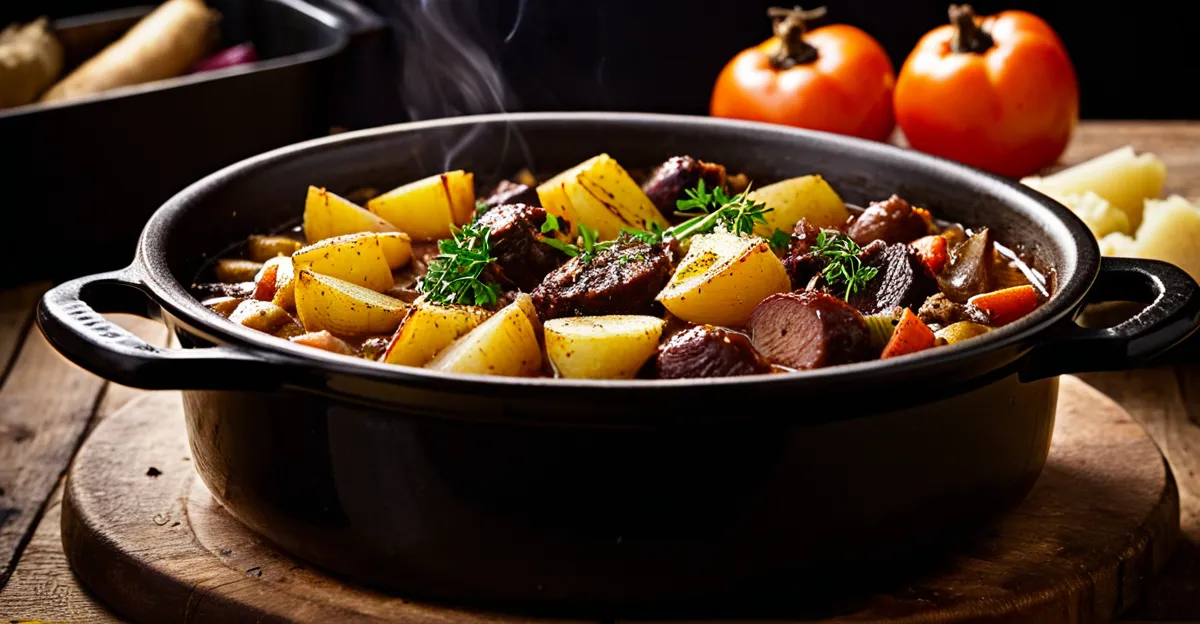Essential Ingredients for a Classic Lancashire Hotpot
Understanding the Lancashire hotpot ingredients is crucial to mastering this traditional British dish. At its heart, the classic Lancashire hotpot recipe relies on a few key elements that combine to create its signature rich, comforting flavour.
The foundation is lamb, ideally using cuts such as shoulder or neck. These cuts are known for their tenderness and flavour after slow-cooking, vital to an authentic Lancashire hotpot. Next come onions, which add sweetness and depth as they soften and meld into the meat. Potatoes form the iconic topping and a layer of heartiness beneath, sliced thin to ensure they cook evenly, producing a beautifully soft yet slightly crispy finish. Finally, a good quality stock, preferably lamb or beef, is essential to infuse moisture and enhance the dish’s robust taste.
Also to see : What are the essential spices for authentic UK curries?
While some variations include carrots or herbs, the traditional Lancashire hotpot avoids overcomplicating the flavour profile. Avoid delicate or fast-cooking vegetables that can disrupt the texture balance. This focus on simplicity keeps the dish true to its roots, celebrating each core flavour without distractions.
Step-by-Step Preparation Process
Careful Lancashire hotpot preparation is key to creating a dish that balances flavour and texture perfectly. Start by slicing the potatoes thinly, as uniform thickness ensures even cooking and a tender yet crisp topping. For the onions, slice them finely or divide into rings; they will soften and sweeten during cooking, blending beautifully with the lamb. When preparing the lamb, trim excess fat but retain enough marbling for flavour and moisture; using traditional cuts like shoulder or neck lamb enhances authenticity.
This might interest you : What are the essential steps for crafting a savory shepherd’s pie?
Next, layering is crucial in how to make Lancashire hotpot successfully. Begin with a layer of meat, then add seasoned onions, followed by a gentle pour of stock to keep everything moist. Finally, top with the sliced potatoes arranged neatly to cover the meat. This layering locks in flavours, prevents dryness, and promotes even cooking throughout.
For seasoning, keep it simple with salt, pepper, and perhaps a touch of thyme or bay leaf. Avoid overpowering spices that could mask the dish’s earthy taste. During assembly, pour just enough stock to reach halfway up the layers, striking a balance between moisture retention and the coveted crispy potato topping.
Cooking and Baking a Lancashire Hotpot
Cooking a traditional Lancashire hotpot requires attention to oven temperature and timing to develop its signature flavours and textures. The recommended oven temperature is generally around 160°C (320°F). This moderate heat allows the lamb and onions to slow-cook, becoming tender while letting the stock infuse every layer with rich taste. Lower temperatures prevent drying out, essential for preserving moisture during the lengthy bake.
For baking Lancashire hotpot, a heavy, ovenproof dish such as a ceramic or cast-iron casserole is ideal. These materials distribute heat evenly, ensuring consistent cooking throughout. The baking time usually spans two to three hours, depending on the lamb cut chosen. This duration gives enough time for the connective tissue in the classic Lancashire hotpot recipe’s meat cuts to break down, yielding succulent meat.
Achieving a perfect golden-brown potato topping is crucial. About 30 minutes before the end of cooking, increasing the oven temperature slightly or uncovering the dish helps crisp the thinly sliced potatoes, adding contrast to the soft, tender layers beneath. This finishing touch completes the Lancashire hotpot cooking instructions for an authentic experience.
Serving Suggestions and Authentic Presentation
Serving Lancashire hotpot traditionally involves simple, hearty accompaniments that complement its rich flavours. Classic side dishes include root vegetables like carrots and parsnips, which can be roasted or steamed to maintain a wholesome balance. Green peas or mushy peas add a pop of colour and freshness, brightening the plate without overpowering the main dish. For an authentic experience, serve the hotpot with crusty bread or buttered Yorkshire pudding to soak up the delicious stock.
When it comes to serving Lancashire hotpot, presentation matters for warmth and appeal. Use a large, shallow dish to keep the potato topping crisp. Serve portions hot and fresh from the oven, ensuring the steaming potatoes maintain their inviting golden crust. If reheating leftovers, cover with foil and warm slowly to avoid drying out, preserving the original moistness and texture that define a traditional Lancashire hotpot.
Keep these tips in mind to enhance your dining experience. By pairing the hotpot with appropriate sides and careful plating, you fully embrace the comforting essence of this classic British dish.





